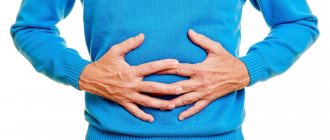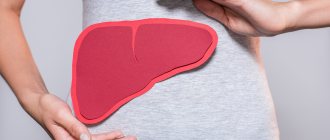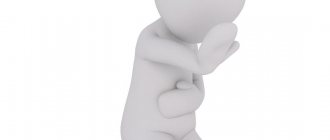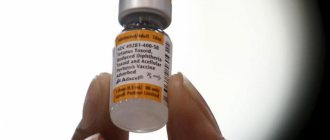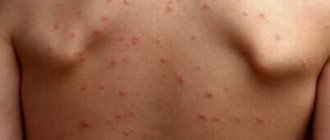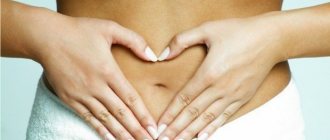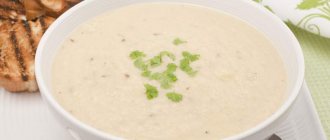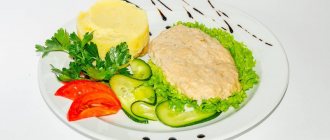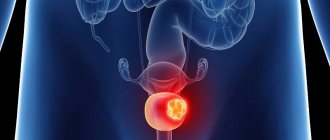When a patient first consults a specialist about biliary colic, this does not mean that an acute pathological process is already underway in the body. Most often, the examination results determine chronic cholecystitis, the treatment of which takes quite a long time.
Symptoms of cholecystitis develop gradually, so often an attack of biliary colic is an exacerbation of the chronic form of a latent gallbladder disease.
In most cases, chronic cholecystitis manifests itself:
- pain in the right hypochondrium;
- decreased appetite;
- bitterness in the mouth;
- nausea, less often - morning vomiting of bile.
During exacerbations of the disease, attacks of cutting pain in the epigastric region or in the right hypochondrium are observed.
The pain can radiate upward and to the right - to the area of the right shoulder blade, right shoulder, right half of the neck. In some cases, pain spreads throughout the abdomen, intensifying when lying on the left side and taking deep breaths.
Diseases of the biliary system
Gallstone disease (hereinafter referred to as cholelithiasis) is a chronic disease of the gallbladder, which can be asymptomatic, exacerbating only with the development of inflammation and blockage of the bile ducts by stones.
GSD already occurs in 10% of the world's population3. Gallstones consist of substances that are poorly soluble in bile, in most cases cholesterol. There are various reasons for the formation of stones: genetic, demographic, dietary, and also due to various concomitant diseases or taking certain medications. The structure of once formed stone constantly changes, anhydrous cholesterol accumulates inside it4.
- Risk factors are age (40-69 years)3, heredity, predisposition, female gender.
- The development of this disease in women is associated with hormonal changes during pregnancy and childbirth, which contribute to the formation of stones5.
During menopause, due to a decrease in sex hormones, the contractility of the gallbladder weakens5.
The connection between cholelithiasis and the nature of nutrition has been proven. Excessive saturation of bile with cholesterol is promoted by foods high in animal fats (fatty meat, milk, cream, lard), simple carbohydrates (fast food, sweets, baked goods). Stone formation is provoked by frequent consumption of spicy seasonings and a deficiency in the diet of vitamins (especially vitamin E)5.
The tendency to stone formation occurs with increased reabsorption of bile acids. This occurs under conditions of slow movement of food through the intestines, which is facilitated by a lack of dietary fiber (vegetables, fruits)5. One of the main factors in the development of cholelithiasis is obesity. Moreover, the risk of stone formation is directly proportional to excess weight. If with a body mass index (BMI) from 25 to 30 the risk of cholelithiasis increases by 2 times, then with a BMI over 35 it increases by 20 times6.
Sudden weight loss also has a negative impact on stone formation. With a sharply limited unbalanced diet, the circulation of bile acids is disrupted, which leads to the formation of stones5.
There is information about the connection between lack of physical activity and the process of stone formation. Thus, in people who spent 40 hours a week watching TV, cholelithiasis was detected 2 times more often. The disease is much less common in people engaged in physical labor5.
Diagnostics
A careful collection of medical history and eating habits plays a major role in determining the cause of pain. During a physical examination, a gastroenterologist checks for cystic symptoms that indicate an inflammatory process. The diagnostic search involves a comprehensive laboratory and instrumental examination of the biliary system. The following methods are used:
- Ultrasound of the gallbladder.
According to sonography, the size and contours of the gallbladder and the condition of the bile ducts are assessed. During the examination, stones and adhesions may be noticed. To study the contractile activity of the organ, a test with a choleretic breakfast is indicated. - ERCP.
The technique of reverse contrasting of the bile ducts is necessary for detailed visualization of their condition, finding small stones that were not visible during sonography. ERCP is performed using an endoscope, so it is both a diagnostic and therapeutic method. - Duodenal sounding.
Obtaining several portions of bile is necessary for its microscopic and bacteriological analysis. An increased number of leukocytes and mucus are found in the bile. During bacterial culture, a mixed bacterial flora is usually found. - X-ray techniques.
A plain radiography of the abdominal cavity is performed to identify complications - calcification of the gallbladder wall, free gas under the diaphragm. To clarify the diagnosis, cholecystography, MSCT of the abdominal organs, and dynamic scintigraphy of the hepatobiliary system are recommended. - Laboratory research.
In the hemogram for inflammatory diseases of the gallbladder, leukocytosis and increased ESR are detected. A biochemical blood test is performed to look for signs of cholestasis (increased alkaline phosphatase and cholesterol levels) and to assess the content of direct bilirubin.
The list of gallbladder diseases also includes less common pathologies:
- Congenital anomalies of the biliary tract - changes in the size, shape of the biliary tract, size of the gallbladder. Pain in these cases can occur when the bladder is torsion or volvulus2.
- Congenital anomalies of the bile ducts - atresia (congenital absence), underdevelopment (hypoplasia). These anomalies usually appear in early childhood2.
- Bile duct cysts. They develop very slowly, so in about half of cases symptoms appear decades later2.
- Choledocholithiasis is the formation of stones in the common bile duct, usually occurring in old age. It may not manifest itself in any way for several years2.
Treatment
Help before diagnosis
For mild pain, indicating a chronic process, it is permissible to limit yourself to non-drug methods. The patient is given a detailed diet plan, which involves the exclusion of animal fats, extractives, and alcohol. The diet depends on the preservation of the biliary function of the bladder. To increase the volume of bile, mineral waters are prescribed. In case of an acute pain attack, you should go to the hospital as soon as possible.
Conservative therapy
Drug treatment is carried out for uncomplicated forms of gallbladder disease, without the risk of organ destruction. At the initial stage, antispasmodics and analgesics are used to relieve painful symptoms. Then etiopathogenetic therapy is selected, which may include several groups of drugs:
- Antibiotics
. For exacerbation of cholecystitis and cholangitis, broad-spectrum antibacterial drugs are used. To accelerate the elimination of bacterial toxins and endotoxins, treatment is supplemented with infusion therapy. - Choleretic agents
. After stopping the acute process, drugs are prescribed that improve the flow of bile. They are divided into 2 groups: cholekinetics, which stimulate the contractile activity of the gallbladder, and choleretics, which increase the volume of the water component of bile. - UDHC
. The use of ursodeoxycholic acid is one of the methods of non-surgical treatment of cholelithiasis. With long-term use (up to two years), the active substance dissolves stones and helps normalize the biochemical composition of bile.
After the elimination of acute inflammation, physiotherapeutic techniques are prescribed. For chronic cholecystitis, it is advisable to use reflexology, SMT therapy, and electrophoresis. It is effective to use decoctions of medicinal plants that have hepatoprotective and choleretic properties. Spa treatment at balneological resorts is recommended.
Cholecystectomy. Gallbladder stones
Lithotripsy
For calculous cholecystitis, methods of non-invasive crushing of stones are widely used. In gastroenterology, extracorporeal shock wave and contact lithotripsy are more often performed. This treatment is characterized by the absence of tissue trauma and a short rehabilitation period. Lithotripsy is only required for stones up to 2 cm in size.
The nature of pain in various pathologies
Diseases differ in the nature of the expression of the main symptom. There are several reasons for their development, and all of them are divided into the following groups:
- Metabolic disorders.
- Manifestation of functional diseases.
- Inflammation.
- Injury.
- Congenital defects.
Let us consider in more detail the pathologies from these groups.
| Disease | Image | Symptoms |
| Cholecystitis, cholesterosis | An inflammatory process that forms in the mucous membrane of an organ. The main causes of the pathology are poor nutrition, diseases of the biliary tract (presence of stones in the bladder), inflammatory processes developing in adjacent organs. In acute development, the following conditions are present: · cutting sensations in the liver area; · hyperthermia (up to 39-40 degrees); · pathological changes in the functioning of the digestive system (nausea, vomiting, belching, bowel dysfunction); · drying of the oral mucosa; · febrile conditions; · increased fatigue. In the chronic stage of the disease there are remissions and relapses. In the initial stage of the disease, there is practically no discomfort; periodic attacks of nausea, weakness, and dull pain in the right hypochondrium are possible. | |
| Cholelithiasis | The development of the disease is facilitated by metabolic disorders in the body, changes in the consistency of bile, unbalanced nutrition, insufficient physical activity, increased body weight, and hormonal imbalance. The intensity of the pain syndrome directly depends on the number, size of stones in the bladder, and location. The initial stages of the disease are characterized by sluggish symptoms, which subsequently increase significantly. In this case, the following signs of pathology appear: · slight cutting sensations in the right side of the hypochondrium, radiating to the scapular region, shoulder joint, arm; · urge to vomit; · feeling of fullness in the abdomen, increased gas formation; · bitter taste in the mouth. When the bile ducts are blocked by stony substances, a sharp, unbearable pain sensation occurs, which intensifies during a sigh or a change in body position. Quite often this condition is accompanied by nausea and vomit. Unpleasant symptoms can be triggered by excessive physical activity, shaking while riding in public transport, or sudden turns of the body. | |
| Dyskinesia | Pathology is a violation of the discharge of secretory fluid due to a malfunction of the biliary tract, the organ itself. The disease is provoked by frequent stressful situations in which the patient finds himself, heavy physical labor, and lack of diet. The initial stage of the disease is not characterized by particularly pronounced symptoms. Further development is manifested by the following conditions: · pain of a pulling, aching nature, localized in the right hypochondrium; · persistent loss of appetite; · presence of belching, accompanied by a bitter taste; · nauseating conditions; · bloating | |
| Bend of the gallbladder | This pathology indicates a decrease in the functional abilities of the organ. The following pathologies contribute to bending: · congenital abnormalities of the anatomical structure; · deformation, displacement of neighboring organs as a result of excessive physical activity; · pathological enlargement of the liver. The pathology is accompanied by such conditions as: · pain in the lower abdomen; · urge to vomit; general intoxication of the body, accompanied by nausea and weakness; · increased sweating; · accumulation of gases in the intestines. The occurrence of pathology provokes the development of pancreatitis, gastric ulcer, the formation of erosions on the mucous membranes of the stomach, and cholelithiasis. The disease is dangerous due to the risk of cracks that can release secretory fluid into the abdominal cavity. | |
| Presence of tumors | Symptoms characteristic of cancerous tumors appear depending on the severity of the pathology. In the first stages of cancer development, there is no pain. Subsequent stages are characterized by the presence of the following symptoms: · pronounced pain that cannot be relieved by taking antispasmodic medications; · disruption of the gastrointestinal tract, accompanied by intestinal upset; yellowing of the skin; · sudden weight loss; accumulation of free fluid in the abdominal cavity, accompanied by a sharp deterioration in the patient’s general condition |
What is the importance of bile for the body?
In the human body, one of the important organs is the liver. Its functionality includes several important actions, one of which is the formation of bile. The biological fluid synthesized by the organ is directly involved in the digestive process. After its formation, the liver pushes bile through a special duct into the gallbladder, where it accumulates and concentrates.
Preserved as a single clot, a certain amount of biological substance can be released from the pear-shaped bladder into the intestinal area to participate in the processing of food products entering the esophagus. This is especially true for excessively fatty, fried foods. During normal functioning of the organ, the ejection process occurs approximately 2 hours after food intake.
The main function of bile is the breakdown of fat components absorbed by the body. This promotes high-quality absorption of nutrients, elimination of harmful components, and synthesis of protein cells. The secretion of bile stimulates the normal functioning of the stomach and intestines, and promotes optimal production of enzymes by the pancreas.
Another important feature of bile is the protection of intestinal microflora from penetration and proliferation of pathogenic microorganisms in it.
